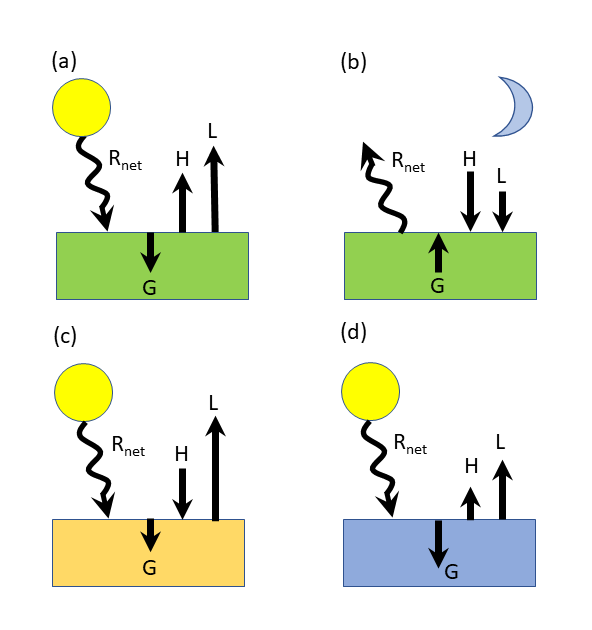11.12 The Surface Layer’s Energy Budget
In Lesson 7, we looked at the energy budget of the average atmosphere. Now let’s look at the energy budget at Earth's surface. We can think of this budget in terms of energy fluxes and energy storage. As you learned in Lesson 2, energy is conserved—it must go somewhere.
There are several basic terms that we can put together in an energy equation that is appropriate for different environments or times of day. The units of the terms are W m–2.
The main energy terms are:
Rnet H L G S
Using these flux definitions, we can write an equation for the surface energy budget:
The ratio of sensible heat flux to latent heat flux is called the Bowen ratio:
It can be either positive or negative:
- > 10 over deserts,
- 2 – 6 over semi-arid lands or over crops and forests when the leaves are not out,
- 0.4 – 0.8 over grasslands and forests during growing season (the ratio is lower when water is abundant and higher when it is dry),
- < 0.1 over oceans,
- negative over oases.
Looking at this list, it is easy to see that the water vapor comes not only from the surface moisture but also from trees and other plants by a process called evapotranspiration.

Look at the figure above, which shows the relative values of energy fluxes for different environments and times of day:
- (a) daytime: solar heating dominates; heating is going into upward latent and sensible heating and warming the ground. The Bowen ratio (ratio of the sensible to the latent heat fluxes) depends on the amount of vegetation and surface moisture. The heating of the ground’s surface causes a downward energy flux into the ground.
- (b) nighttime: no solar shortwave; radiation is all infrared and is less than during the day, which has a net loss of energy to space. Both latent and sensible heat fluxes are negative because the ground is cooling and water vapor is condensing, leading to a positive gradient in temperature and specific humidity. The subsurface ground is warmer than the surface, so there is an upward energy flux from the subsurface to the surface.
- (c) daytime oasis with warm air advection over a moist surface: solar heating, sensible heat flux downward from hot dry air, latent heat flux upward offsetting some of the heating from the solar flux and the downward sensible heat flux. The surface is still heating, so some energy flux goes into the ground. The oasis is cooler than the surrounding desert because of the large latent heat flux.
- (d) daytime ocean: sensible and latent heat fluxes are positive, but much of the downward surface flux carries significant energy down into the ocean away from the surface. The ocean has a lot of heat capacity, so that solar energy can be absorbed in the ocean with little temperature change. Most of the energy goes into the ocean, with fairly constant fluxes of latent heat and sensible heat.
Quiz 11-3: Energy in the boundary layer.
- Please note: there is no practice quiz for Quiz 11-3.
- When you feel you are ready, take Quiz 11-3 in Canvas. You will be allowed to take this quiz only once. Good luck!